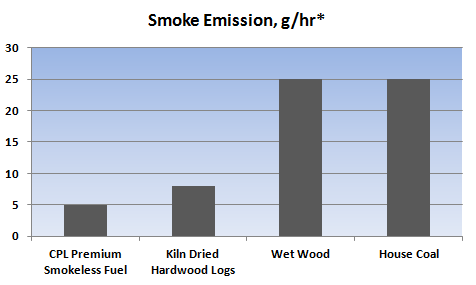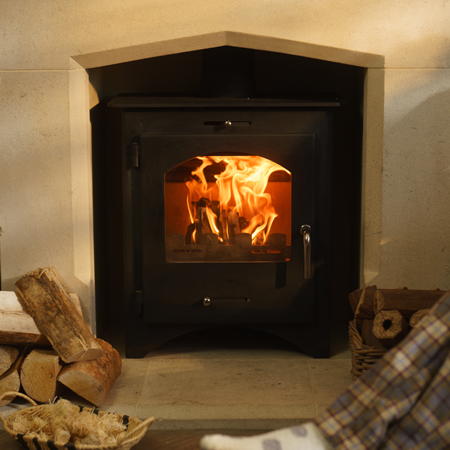
Firewood Advice
As one of the nation’s top suppliers of firewood, CPL aims to provide the widest range of choice for customers who want to order wood online. This advice is designed to help you select and burn firewood safely and efficiently.
Collapsible content
What Does The Wet Wood Ban Mean For Me?
From May 1st 2021, you will no longer be able to buy wet wood from any retailer. Fortunately for our existing customers, they have been using our Homefire Kiln Dried Firewood which will still be available to buy for the foreseeable future.
If you are looking to switch to a Kiln Dried Wood, at Homefire, we have a certification that helps you identify less polluting dry wood which will still be available to buy online at Homefire. The wood is verified by our independent inspectors as having a moisture content of up to 20% which means it burns with less smoke than wetter wood; and is labelled Woodsure Ready to Burn.
How Do We Make Our Kiln Dried Wood?
Watch our video to understand how we turn sustainably sourced wood into ready to burn kiln dried firewood.
Where Do We Get Our Wood From?
At Homefire we believe it's important to get our wood from sustainable forests. Watch our video to find out more.
What Is The Ready To Burn Scheme?
Ready to Burn is a Government backed scheme designed to promote the burning of properly dry firewood – which means wood that has a moisture content of less than 20%.
Better for you, better for the environment
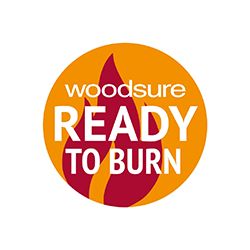
Burning Ready to Burn firewood results in 75% less smoke emissions than burning wet wood – which is especially important when you consider that poor air quality is reported to contribute to the early death of over 40,000 people every year in the UK.
Ready to Burn firewood is also better for your appliances as wet wood can blacken your stove glass and build up soot in your chimney.
So when you’re choosing firewood look out for the orange Ready to Burn label – you’ll know you’re getting the best wood for yourself, your fire and your planet.
As one of the leading firewood suppliers in the UK, we feel it is important that we not only lead the way in raising awareness of Ready to Burn firewood, but also supply our customers with the best choice of products.
All You Need To Know About Burning Firewood
Product Guide
- Kiln dried logs are the highest quality logs available - less than 20% moisture content
- Dry Wood Good: Wet Wood Bad - For multiple different reasons: it gives a rubbish fire, emits lots more smoke and clogs up your chimney with tar increasing the risk of chimney fires. All these problems go away when you use dry wood
- Dry wood is when it has a moisture content of less than 20%
- Burning logs and smokeless coal together can be beneficial to your appliance
- Only burning dry wood will minimise the risk of damage to your appliance
Kiln Dried Logs
Homefire's Kiln Dried Logs are Ready to Burn which means they are dried to an average of less than 20% so they are ready to use immediately, perform extremely well, and are very efficient. Some of the highest quality logs available, Kiln Dried Logs burn much hotter than regular seasoned logs or wet logs. This higher temperature makes kiln-dried wood considerably more efficient and economical to burn, as well as helping to prolong the life of your appliance. Any sap or water remaining in the wood is burnt off, preventing it from building up inside your appliance as tar.
- Ready to Burn - Less than 20% moisture
- High heat output, low smoke
- Ideal for use on wood burners, multi-fuel stoves, and cookers
- Protects the warranty of your appliance
Find out more about the Ready to Burn scheme via our Knowledge Base or read this article by consumer magazine Which.
Heat Logs
- Manufactured from pure wood waste
- Low moisture content
- Ready to burn immediately
- Ideal for use on multi-fuel stoves, open fires, wood burners, and chimeneas
Heat logs, or fire logs, are manufactured logs which can be burnt immediately. They can be burnt alone, or used as an aid in starting a fire. Our heat logs are made from recycled wood waste, so they’re also better for the environment.
Seasoned Logs
- Contain less than 30% moisture
- Ready for use in 1-2 weeks
- Good heat output
- Ideal for use on multi-fuel stoves, open fires, wood burners, chimeneas, and braziers
- Seasoned wood burns with medium heat output. We recommend that seasoned logs be allowed a drying time of several weeks before being burnt.
Unseasoned Logs
- Contain between 45% and 60% moisture
- Ready for use in 6-12 months
- Low-medium heat output
- Ideal for DIY seasoning
Unseasoned wood provides a low-cost option which is best suited to open fires. Hardwood and softwood netted logs have a moisture content that is typically between 45% and 60%, so we recommend that they be allowed adequate time to dry or season prior to burning.
Fire and Chimney Safety
Potential dangers from burning wet wood
Burning wet firewood can result in two very serious problems associated with condensation in the chimney.
Blockages and chimney fires
Water vapour combines with other gases and particles going up the chimney and unless the chimney is kept warm, the condensation forms a creosote-like substance which hardens to form tar on the surface of chimney liners and may seep into brickwork in an unlined chimney. Wet wood causes the chimney to cool and so condensation occurs and a residue is formed.
The residue is brown or black and can be flaky, sticky, runny, tar-like or hardened and will sometimes be all of these in the same flue. The chimney may become completely blocked or the volatile residue can ignite causing a dangerous chimney fire.
Corrosion
The excessive condensation from wet wood which normally forms in the upper part of the chimney is acidic in nature and will corrode the inner surface of a metal liner, eventually leading to perforation and failure of the liner.
Keep your Chimney Clean
Having your chimney swept regularly will help your fuel burn more efficiently, and minimise any risk of damage to your appliance or chimney. The following frequencies are the minimum recommended by the Guild of Master Chimney Sweeps. Your chimney sweep will be able to better advise the correct sweeping frequency for your situation.
- Smokeless Coal – At least once per year
- Wood – Up to four times per year
- Bituminous Coal – Twice per year
Visit the Guild of Master Chimney Sweeps, NACS, or APICS to find a reputable, reliable sweep near you.
Fit Smoke and Carbon Monoxide Alarms
Smoke and Carbon Monoxide detectors should be fitted in every home, whether the owners burn solid fuel or not. An audible alarm will alert you to any danger wherever you are in the house. Carbon Monoxide is a colourless, odourless, and tasteless gas which can be fatal if inhaled in large quantities. A carbon Monoxide alarm is a reliable way of detecting carbon monoxide before it reaches dangerous levels.
Fire and Chimney Safety Tips
- Don’t store wood or other flammable materials next to your fire or stove
- Try to use wood that is dried to 20% moisture or less
- Don’t leave open fires unattended
- Use a fire guard when necessary
- Have your chimney swept regularly
- Use audible smoke and carbon monoxide detectors
Hardwood versus softwood
For the majority of fuel burners, hardwood logs would be the best choice. This is because they are much denser than softwood and therefore produce higher heat. Due to these higher temperatures, you’ll also need fewer hardwood logs in order to heat your home, meaning longer refuelling intervals. However, softwood tends to light more easily than hardwood and burns faster due to its resin content. It gives more immediate heat so is ideal for kindling and initial burning.
Which hardwood? Ash, Birch or Oak
When it comes to finding the best wood to burn on your open fire or multi-fuel stove, there’s plenty to choose from, each with its own burning qualities. But hardwoods are generally denser than softwood and therefore burn for longer and we’d particularly recommend Ash, Birch and Oak which all have a lengthy burn time due to their greater density.
Here’s a rundown of each wood’s burning qualities.
Ash
Reckoned by many to be one of best woods for burning, it produces a steady flame and good heat output. It can be burnt when green but like all woods, it burns best when dry.
One of the best woods for a steady fire and good heat. Although ash will burn when green, it burns better when seasoned. Ash wood produces excellent heat, a nice flame and it lasts reasonably well.
Birch
Produces good heat output but it does burn quickly. It can be burnt unseasoned, however the sap can cause deposits to form in the flue with prolonged use.
These logs burn quickly but nevertheless provide good heat output, bright lively flames and a pleasing smell. Best mixed with other slower burning logs such as Elm (particularly slow burning), Ash or Oak.
Oak
Because of its density, oak produces a small flame and very slow burn, it is best when seasoned for a minimum of two years as it is a wood that requires time to season well.
Generally considered one of the very best wood fuel logs and therefore much sought after. However it must be seasoned for a long time – at least two years. It burns fairly slowly with nice flames and produces an excellent long lasting heat even when only the embers are left.
Environmentally Friendlier Wood Fuel
We work hard to ensure that all of our firewood is responsibly sourced, ensuring that future generations can also enjoy the comfort of a real log fire without harming the environment.
Ready to Burn
Ready to Burn is a Government backed initiative designed to encourage users to only burn firewood dried to less than 20% moisture content. This is because dry wood emits much less smoke than wet wood. From the Government's perspective Ready to Burn is about improving air quality, but for the user they also benefit from better heating performance, less tar build up in stoves and chimney flues and an all around better quality product. Look for the red and orange Ready to Burn logo when purchasing firewood online and on product packaging.
Sustainably Sourced
Much of our wood fuel is sustainably sourced within the UK. When you buy products from Homefire you help to:
- Prohibit the conversion of natural forests and other habitats around the world
- Reduce the use of highly hazardous pesticides around the world
- Reduce the cultivation of genetically modified trees
- Build respect for the rights of indigenous peoples around the world
How To Light A Log Fire
Step 1 - Prepare Your Stove
Before you begin the process of lighting your log fire, ensure that your appliance is in good working order. Your chimney should be cleaned bi-annually by a qualified chimney sweep, and the place where you wish to light your log fire must have suitable and adequate ventilation.
A steady air supply is essential—fire needs oxygen to thrive. Make sure any air vents are open and, if indoors, keep a window slightly ajar to help airflow circulate and support combustion. Lack of ventilation is a common reason why fires fail to light or die out quickly.
Step 2 - Rake the Grate to Remove Remaining Ash
Rake the grate using your poker and allow any old ash to fall into the ash pan below. Using the brush, sweep away any remaining ash, leaving your fireplace and hearth clean. Don't clear out the grate completely (just get rid of the ash and small cinders) as you may have some part-burnt pieces of log fire wood or solid fuel left, which are ideal to help get your log fire off to a good start.
Step 3 - Empty the Ash Pan
Cinders, from a previous log fire, that have fallen through the grate can remain hot for many hours, so be careful and do not empty hot ash and cinders into combustible containers – a metal container placed on the hearth is ideal - keep this away from carpets as the heat will transfer. Remove any decorative parts of the fire bed to gain access to the ash pan. Have your container close to hand and slowly tip the ash into your container. Be careful how quickly you tip it as you may end up covered in a cloud of ash if you do it too fast. Remove the ash from the room and replace the component parts of the fire bed so that you are in a position to lay your log fire.
Step 4 - Lay the Firelighters and Kindling
Place two or three firelighters on your fire bed.
To make a combustion chamber around the firelighters, put one piece of kindling against the appliance's back wall. You should then place four or five more pieces of kindling against this first piece. Be careful to leave enough space to reach the firelighters.
Tip: Consider stacking your kindling in a criss-cross pattern to improve airflow between pieces and help the flames catch more evenly. You can also place a few scrunched-up sheets of newspaper underneath for a natural and effective way to get the flames going.
Step 5 - Light the Fire
Light the firelighters and wait until the kindling begins to burn.
If the kindling struggles to catch, you can gently blow on the fire to give it an extra boost of oxygen and encourage combustion. Just be cautious when doing so, always keep your face at a safe distance.
Step 6 - Wait and Enjoy
Once the flames on the log fire are established, add some small logs to the fire. Once these are burning well add some larger logs, always looking to place logs where they can help the fire spread to fill the grate. One reason why a log fire goes out is that people are too impatient, and load the log fire with fuel before the base of the fire has established itself. Avoid piling on too much wood too soon—three or four small logs are plenty in the early stages.
When you are happy that there is sufficient fuel on the log fire, replace your fire guard, clear away any fire-making materials and refill your log basket. You can then sit back and enjoy the warm log fire that your burning fireplace logs bring to your living room!
Fuel tip: The quality of your fuel plays a huge role in how well your fire lights and burns. Always use seasoned or kiln-dried firewood—our Kiln Dried Firewood is ultra-dry, easy to light, and smokeless, making it a great choice for both indoor fireplaces and outdoor fire pits. Likewise, using proper kindling, like our Kiln Dried Kindling, gives your fire the best possible start. Using damp or substandard wood will only make lighting more difficult.
* The advice we give is not exhaustive and therefore not complete. Should you choose to act upon any of the information given to light your log fire, you should do so at your own risk. We will accept no liability nor claims from actions arising from the information set out in these web pages.
What Are The Problems Of Burning Wet Wood?
Potential dangers from burning wet wood
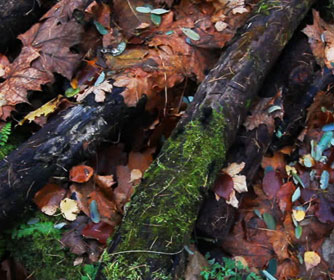
Burning wet firewood can result in two very serious problems associated with condensation in the chimney.
Water vapour combines with other gases and particles going up the chimney and unless the chimney is kept warm, the condensation forms a creosote-like substance which hardens to form tar on the surface of chimney liners and may seep into brickwork in an unlined chimney. Wet wood causes the chimney to cool and so condensation occurs and a residue is formed.
Blockages and chimney fires
The residue is brown or black and can be flaky, sticky, runny, tar-like or hardened and will sometimes be all of these in the same flue. The chimney may become completely blocked or the volatile residue can ignite causing a dangerous chimney fire.
Corrosion
The excessive condensation from wet wood which normally forms in the upper part of the chimney is acidic in nature and will corrode the inner surface of a metal liner, eventually leading to perforation and failure of the liner.
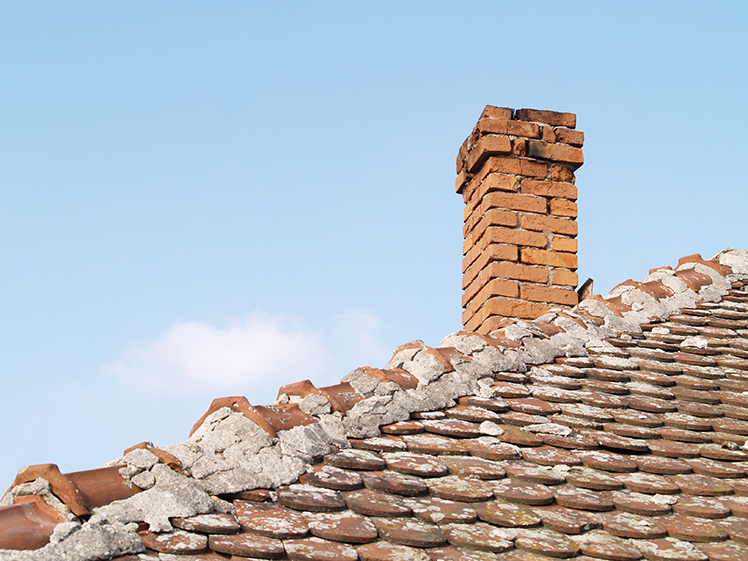
Keep your Chimney Clean
Having your chimney swept regularly will help your fuel burn more efficiently, and minimise any risk of damage to your appliance or chimney. The following frequencies are the minimum recommended by the Guild of Master Chimney Sweeps. Your chimney sweep will be able to better advise the correct sweeping frequency for your situation.
- Smokeless Coal – At least once per year
- Wood – Up to four times per year
- Bituminous Coal – Twice per year
Visit the Guild of Master Chimney Sweeps, NACS, or APICS to find a reputable, reliable sweep near you.
Fit Smoke and Carbon Monoxide Alarms
Smoke and Carbon Monoxide detectors should be fitted in every home, whether the owners burn solid fuel or not. An audible alarm will alert you to any danger wherever you are in the house. Carbon Monoxide is a colourless, odourless, and tasteless gas which can be fatal if inhaled in large quantities. A Carbon Monoxide alarm is a reliable way of detecting carbon monoxide before it reaches dangerous levels.
Fire and Chimney Safety Tips
- Don’t store wood or other flammable materials next to your fire or stove
- Try to use wood that is dried to 20% moisture or less
- Don’t leave open fires unattended
- Use a fire guard when necessary
- Have your chimney swept regularly
- Use audible smoke and carbon monoxide detectors
To read DEFRA's guide to open fires and wood-burning stoves, click here.
A Customer's Tale: The True Cost Of Burning Wet Wood
We sometimes hear stories from our customers, who have tried to save themselves a few pennies by collecting their own firewood from the local woods or buying it cheap off the back of a lorry. But the truth is that burning wet firewood is a false economy and will cost you more in the long term. Instead, we recommend only burning kiln-dried firewood for the following reasons:
- Greater heat output than wet wood
- Greatly reduced emissions and improved air quality compared to burning wet wood (see graph below)
- Better for your appliance – the stove glass will not blacken and soot will not build up as quickly in your chimney
- Better value than seasoned and unseasoned wood (wet wood)
- Ready to Burn - no need to store and wait years for them to dry
Take a look at the following example. Our new customer John certainly agrees...
The 2017/18 UK winter was the coldest in years and served as a reminder that the need to warm your home is more important than ever. If you have a multi-fuel stove and love burning firewood, it’s tempting to try and save yourself a few pennies by collecting your own wood fuel from local woodlands and parks.
Take one of our new customers, John. Having recently bought a brand new multi-fuel stove, John indulged in a spot of foraging and went collecting freshly fallen branches for firewood (known as ‘non-seasoned wood’ or ‘wet wood’). Unfortunately, this is where things started to go wrong. A few weeks of attempting to burn the wet wood proved a disappointing experience for John with his stove taking ages to light due to the high moisture content of the wood he collected.
Because the wet wood is such low-quality firewood (with a moisture content of between 45% and 80%), it gives off very little heat, burns very slowly, and may even go out as it is so wet. It gives off less heat because the energy is used up driving off the water in the wood, resulting in steam and a dismal spitting fire with very little heat output.
To sustain any heat at all John was constantly refuelling the fire and was soon running out of stock. As well as poor heating performance, the wet wood’s burning inefficiencies result in more emissions, smoke, and pollutants into the atmosphere, negating the benefits to the environment. These emissions contain tar, soot, and highly flammable creosote which can also clog up a chimney or flue leading to more calls to the chimney sweep.
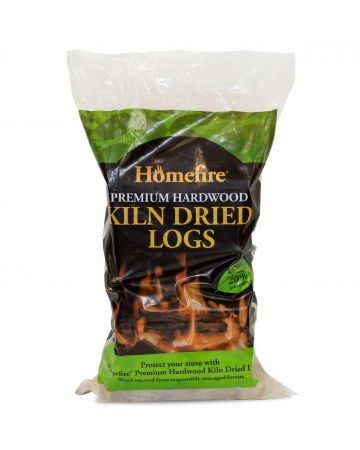
John gave up eventually but if he’d persisted in burning the wet wood, the build-up of highly flammable creosote would have severely damaged his flue liner and in the worst-case scenario resulted in a chimney fire. John could have seasoned his wood to dry it out first, but this can take months, if not years, depending on the species of wood.
If you love burning firewood and want to burn it straight away, there’s a very straightforward way to avoid these problems. We would strongly recommend that you only use Homefire's range of Homefire Kiln Dried Logs which are certified as Ready to Burn by Woodsure and sourced from sustainable forests. Watch our videos to see where we source our wood and how we make kiln dried logs.
This means moisture content is 20% or below so they burn hotter, at a higher temperature, and as the names suggests can be burnt straight away with no additional drying time. The higher temperature makes kiln-dried wood considerably more efficient and economical to burn, as well as helping to prolong the life of your appliance. Kiln-dried firewood is also more environmentally friendly as the burning of such dry wood emits much less fine particulate matter into the atmosphere. Any sap or water remaining in kiln-dried wood is burnt off, preventing it from building up inside your appliance as tar.
As a new customer, John is now buying Homefire Kiln Dried Logs and enjoys a warm, crackling log fire every night.
Remember, if you love burning firewood buy Ready to Burn kiln-dried hardwood logs.
Can I Burn Smokeless Coal And Kiln Dried Logs Together?
Turn up the heat
Burning coal and logs together can produce a gorgeous fire mixing the aroma and long flames of a log fire with the high heat output and longevity of solid fuel. Mixing fuels can also be beneficial to your appliance, as the higher temperatures produced by the coal help to drive off any moisture in the logs, reducing the build-up of tar.
Getting the mix right
We recommend that only smokeless coal and Ready to Burn kiln-dried wood. The lack of moisture in the wood is crucial, so if you don’t use kiln-dried wood always ensure that your firewood is well seasoned before burning it with coal.
Our customers have told us that their favourite smokeless fuels to burn with logs are Homefire Ovals and Ecoal.
Always follow the manufacturer's instructions for your appliance with regards to choosing a fuel, and mixing fuels.
If you’re buying firewood to warm your home, Homefire kiln dried logs are the highest quality firewood available for multi-fuel stoves and open fires as they burn at a high temperature with a bright, natural flame.
Our kiln-dried logs are also now officially certified by Woodsure Ready to Burn scheme which means they’re dried to less than 20% moisture.
What Fuels Can I Burn In A Multi-Fuel Stove?
So, you’re thinking of buying a multi-fuel stove, but not exactly sure what you can burn in it. We supply a range of multi fuel options no matter your needs, from long burning, extra hot flames and eco-friendly solutions.
Burning Smokeless Coal in a Multi-Fuel Stove
Ecoal
A revolutionary smokeless coal that’s made with up to 50% renewable materials. Provides a high and sustained heat output, while being better for the environment.
Homefire Smokless Coal
Our best performing smokeless coal – it lasts up to 40% longer than house coal, producing great heat performance and burning with a beautifully natural flame.
Homefire Ovals
A slow-burning smokeless coal that packs together in the grate to provide maximum heat output for up to nine hours.
Taybrite
A multi-purpose smokeless fuel that’s easy to light and produces a long-lasting controllable heat. Taybrite can also slumber for long periods.
Burning Firewood in a Multi-Fuel Stove
Ready to Burn Kiln Dried Logs
The highest quality logs available, they have a very low moisture content and will burn at a high temperature and with a natural flame and aroma.
Heat logs
Easy to light logs that burn with a long flame and a good heat output. Often used as an aid to lighting fires, or to top up existing fires. Made from 100% recycled wood.
Seasoned hardwood logs
Long-burning logs burn at a high temperature to produce a naturally beautiful and aromatic flame.
Other Logs
If you cut your own logs or buy them from other suppliers, always make sure they are properly seasoned before you burn them, as wet wood can damage your stove or chimney. However, to save you time and money in the long run, we’d recommend you only buy Ready to Burn Kiln Dried Logs.
Burning smokeless coal and firewood together
Burning smokeless coal and firewood together can be beneficial to your multi fuel stove. The extra heat from the solid fuel drives off any moisture in your logs, significantly reducing the build-up of tar and rusting. A fire of both smokeless coal and firewood will also burn hotter for longer.
Don’t use house coal in a multi fuel stove
Unless specifically stated in your manufacturer’s guide, avoid using house coal in your stove. It burns at a much higher temperature, which may cause damage and the smoke will blacken your stove’s glass.


